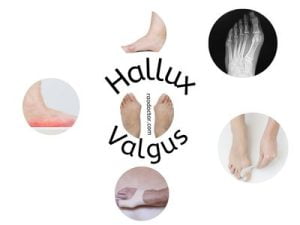Realign Your Big Toe and Regain Your Foot Health with Hallux Valgus treatment
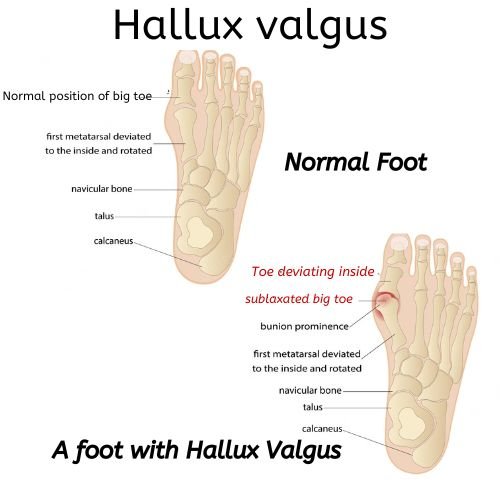
The hallux is the big toe, which is located on the back of your foot. Sometimes, this toe may not be aligned with the other toes and can appear to be angled toward the second toe. This condition of the big toe leaning toward the second toe is known as hallux valgus or hallux valgus angle.
UW MEDICINE
Listen to this article
Hi, this is Dr. K. P. V. Rao and today I will be explaining everything about this condition-Hallux Valgus. Before that, let me show you some pictures about different types of foot we come across in various people and its deformity causing this condition-
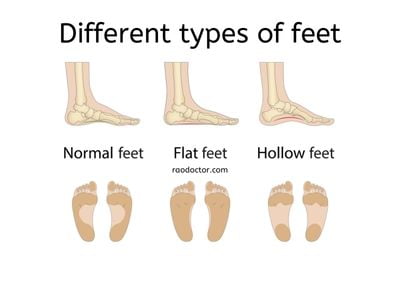


So, what exactly causes this sort of deformity?
This deformity can be caused by a variety of factors, including genetics, wearing tight shoes, or having an abnormal foot structure, like flatfoot.
As far as genetics is concerned, there is no solid evidence, but I think it is true, because my father had it and so do I.
One of the primary reasons for the great toe leaning towards other toes in Hallux Valgus is due to the imbalance of forces acting on the foot.
Why do you get Hallux valgus? The mechanism-
The muscles and tendons in the foot work together to maintain balance and stability, but when there is an imbalance in these forces, it can cause the great toe to shift towards the other toes.
As the tensile strength of the tendons and ligaments holding the great toe (hallux) and the first metatarsal bone weakens, the hallux leans towards the toes and the metatarsal bone (have look at the first picture at the beginning of this article) particularly its head, deviates medially (towards inner side of the foot), creating a bunion and causing the deformity termed valgus.
Another factor that contributes to Hallux Valgus is the wearing of tight or narrow shoes. When you wear shoes that are too tight, they can compress your toes, leading to a misalignment of the bones in your foot. This can cause your great toe to lean towards your other toes and lead to the development of Hallux Valgus.
Additionally, people with certain foot structures may be more prone to developing Hallux Valgus. For example, if you have flat feet or a high arch, you may be more likely to develop this condition due to the abnormal pressure placed on your foot.
After looking at the pictures above you must have got a fair idea about hallux valgus and its causes. So, flatfoot is the leading cause of your great toe to lean inwards, over or below the second toe, starting with bunion formation.
And while it doesn’t have serious implications for people who have it, leaning big toe can make fitting into certain shoes or sandals very difficult. I am experiencing this every day.
In one of my articles on Gout, I mentioned how gout can cause bunion formation. A bunion can then lead to hallux valgus deformity. If you have not read that article, you can read it here-
It can also cause various issues within your gait. If you suspect that you might have this condition, read on to learn more about Hallux Valgus and what you can do about it if you do…
So, exactly what is Hallux Valgus?
Hallux valgus is a deformity in which the big toe leans toward the second toe on the back of your foot. During normal alignment, your big toe would point straight ahead. (Have a look at the picture just below the heading)
As mentioned earlier, the condition can occur as a result of one or more of the following: –
- Increased pressure on the first metatarsal joint (the joint where your toe connects to the foot)
- Increased pressure on the first metatarsal head (the top of the joint)
- Structural abnormalities that are present from birth
- Excessive pronation (rolling in) of the foot
How do You Know if You Have Hallux Valgus?
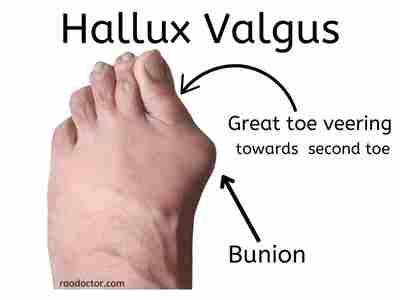
If the joint at the base of your big toe feels out of alignment, or if you can see that your big toe is angled toward the second toe, you may have hallux valgus.
You can also try this simple test: stand with your feet parallel and slightly apart. Then, while keeping your knees bent, slowly bend forward until your hand touches the ground. If your big toe does not touch the ground before your second toe, you could have hallux valgus.

Valgus deformity can be present in a variety of ways.
You may have any one of these pictures-
1. Great toe trying to overlap the second toe [as seen on the right; or
2. Great toe being overlapped by the second toe
What Are the Implications of Having a Leaning Big Toe?
If your big toe is leaning toward the second toe, it can cause pain, aching, and may even lead to arthritis. It can also cause your gait to be altered, which can lead to problems with your knees and hips.
If you have a pair of closed-toe shoes that you love, but you can’t wear them because of your big toe, you can have your toe surgically corrected.
Corrective surgery for hallux valgus
Corrective surgery for Hallux Valgus/bunion surgery can be done with minimally invasive techniques, using small incisions. The description of this surgery is beyond the scope of this article. (Learn all about bunion/hallux valgus surgery).
If you have flat feet, wearing high heels can worsen your condition and lead to other issues. Excessive pronation can be worsened by wearing high heels, and this can result in pain in your feet and ankles, as well as knee and back problems.
Taping your big toe can be an effective way to control the condition. It can also help prevent ankle sprains.
Taping for Hallux Valgus
Taping your big toe is an effective way to control the condition. It can also help prevent ankle sprains.
After you have consulted with a physician to rule out the presence of any serious conditions, you can try taping your big toe to correct it.
How to do taping of your great toe
To do this, first wrap your big toe with a pad to cushion the joint. Then, wrap tape around your foot and up to the joint to bring the toe back into alignment.
You can also try other techniques, like using custom orthotics to keep your foot properly aligned. I use a toe separator with hallux splint like this one [see below]-
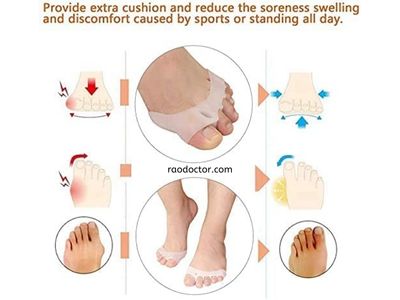
or this one on your right

If you have flatfoot, there is a chance you may develop bunion, hallux valgus and a callus. You can correct this by using an insole with a raised curvature on the inner middle side of your foot [see the image below]-
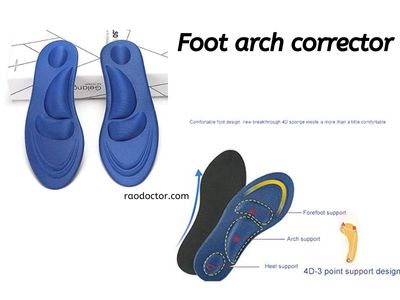
Exercises for Hallux Valgus
Exercises can be performed to strengthen the muscles in your foot and ankle to correct your posture and alignment.
How to exercise your Great toe
While surgery may be necessary in severe cases, there are a few exercises that can help manage hallux valgus. Your podiatrist or chiropractor may recommend these exercises to improve the strength and flexibility of the affected foot.
One exercise that may be recommended is toe stretches. This involves sitting with your legs crossed and using your fingers to gently pull your big toe towards you for 15 to 30 seconds. This can be repeated 2 to 3 times a day.
Another exercise that can help is toe curls. Place a small towel on the floor and use your toes to scrunch it up towards you. Hold for a few seconds and then release. This can also be repeated 2 to 3 times a day.
Additionally, your healthcare provider may suggest a foot roller or massage ball to help relieve pain and inflammation.
Simply roll the device under your foot for a few minutes each day. Strengthening exercises such as calf raises or ankle rolls may also be beneficial.
However, it’s important to consult with your healthcare provider before starting any exercise routine, as they can provide personalized recommendations and ensure you are doing the exercises correctly to avoid injury.
Other exercises for hallux valgus
- You can start by standing with your feet parallel while bending your knees slightly. Then, while keeping your upper body still, try to move your knees away from each other.
- Another exercise is to stand with your feet parallel and slightly apart. Then, while bending your knees, try to squat down as far as you can without moving your feet. When you rise, try to keep your knees bent and stand up straight.
- You can also try walking hills to strengthen your feet and ankles. These exercises can be done with or without shoes and can be done as often as every day. You can also try wearing a pair of supportive shoes with a raised heel.
Bottom line
If you have a big toe that leans toward the second toe, you may want to consider correcting it. You can do this with taping or corrective surgery.
Corrective surgery can be done with minimally invasive techniques, using small incisions. Excessive pronation can be worsened by wearing high heels, and this can result in pain in your feet and ankles, as well as knee and back problems.
You can prevent all of these issues by correcting your condition, and you can also wear high heels if you want.
Useful resources:
Final words
I hope you now have a fair knowledge of Hallux Valgus. You can support me by spreading the word by using the social media icons at the bottom of this article. Alternately, you can Click to Tweet here-
Do you have Hallux Valgus? Learn how to live with it Share on XMy next article will be on the last of the 4 spices of the twelve, a continuation of the series on spices. Be sure to read it by joining my email list by simply subscribing to my articles- it is all free for now.
Adios.
Affiliate Disclosure:
This page has affiliate links. Meaning, if you choose to follow one of these links and make a purchase, I will earn a small commission paid to me by the company (Amazon, Canva or any other links for online purchases), and at no extra expense to you. The commission I make from affiliate sales will help me run this blog and provide regular, quality value to you. So, thank you for your support.

